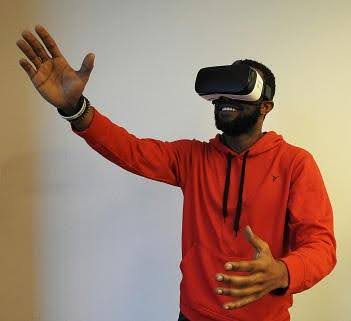Alexander: A fascinating concept in science fiction that relates to time is a particular futuristic concept from the writing of Gene Roddenberry in Star Trek. This involves the ideation of the holodeck: a highly sophisticated computerised environment through which you can program a holographic simulation of the future that you can step into, interact with, and move around in. It looks, feels, sounds and altogether seems absolutely real. You can be in New York in the 1920’s and the cars and buses – everything – is there operating all around you as it was then. You can also simulate a particular scenario in the future, and think about what would happen if…? The holodeck is meant to help think about how we might navigate possible future scenarios. The point worth thinking about is how might we have our own holodecks here and now; how could we do that?
One way is to create mediated multisensory interactive environments (MMIEs – see ref. below) where we can get a sense of being “virtually present” to whatever is being simulated. The more vivid and the more transparent/unobtrusive the technology, the more it feels like we are actually there. Nowadays, technology can be very immersive, like Virtual Reality where you feel like you’re really present to what’s happening. It’s very connecting and very disconnecting, at the same time. The question for me is how we can use this technology to engage with the possible realities that we foresee and often create. It could be very helpful!
Shae: Hmmm, yes, it’s a matter of how technology is engaged. To tune us into human potential in relationship with the cosmos, and perhaps offer knowledge and understanding, on the one hand, or as entertainment only, as escapism, on the other.
Alexander: Yes, how much of it is used within the imaginary domain of human fantasy, or how much is it actually connecting to the imaginal, to the bringing-into-being of the evolutionary impulse of the cosmos? That is, to the deep dimensions of the potential inherent in the holoflux. But I get it, this isn’t necessarily what you want to bring directly into the classroom, I guess.
Shae: Well, it’s very interesting, because what I was thinking about while you were saying this is that pattern thinking is a very simple way of being able to begin to expand our cognition beyond the present moment and situation, and into wider fields of time around and ahead of us. Because we can see in the patterning what was before now and the way the dynamics are moving towards the future. Pattern thinking is not predictive, but it is certainly a tool for stretching and expanding our perspective of time and possible events. As you know, the world emerges from the holoflux through a process of patterning, so it’s quite an appropriate approach.
The patterning provides a cognitive framework for thinking about time in a more complex way, and not just in our own lives, but for others and the world around them. Perhaps I can think about the multidimensional and fractal patterning of Complexity Patterning as a very simple holodeck! I have always thought about having it as an interactive haptic hologram interface, room size! Then we could try on different patternings, various flows of dynamics. A fascinating science fiction! One day maybe…

Image by Hammer Tusk, royalty free by unsplash
Laszlo, A., Rowland R., Taylor G. and Johnston T. (2012). Virtual Learning in a Socially Digitized World. In World Futures: The Journal of Global Education, Vol. 68, No. 8, November, pp. 575-594 [available online at https://www.tandfonline.com/doi/full/10.1080/02604027.2012.730436].
